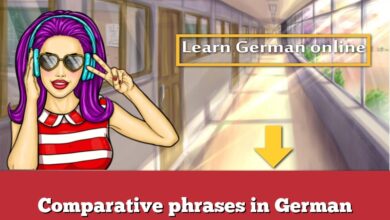Imperatives in German

Imperatives in German is used for giving orders or instructing people to do things.
In English, the imperative works by using the infinitive form of the verb: Go home! Open your books! Close the window!
Whether you are addressing only one person or several, it does not change.
The imperative in German is a bit more complicated. There are different forms depending on whether you are addressing one person only or more than one.
German also distinguishes between the formal and informal mode of address in the imperative.
| singular | plural | |||
| du | Sie | ihr | Sie | |
| kommen | Komm! | Kommen Sie! | Kommt! | Kommen Sie! |
| warten | Warte. | Warten Sie. | Wartet. | Warten Sie. |
| sprechen | Sprich leise. |
Sprechen Sie leise. |
Sprecht leise. |
Sprechen Sie leise. |
| anfangen |
Fang an. |
Fangen Sie an. |
Fangt an. |
Fangen Sie an. |
| haben |
Hab Geduld. |
Haben Sie Geduld. |
Habt Geduld. |
Haben Sie Geduld. |
| sein |
Sei vorsichtig. |
Seien Sie vorsichtig. |
Seid vorsichtig. |
Seien Sie vorsichtig. |
As you can see, the du, Sie and ihr forms follow different patterns. The formal imperative is the same in the singular and plural.
Imperatives in more detail
Here are the different forms in more detail.
Addressing one person informally (du form) The informal singular or du form is used with one person with whom you are quite familiar – children, family or close friends.
Formation
You form the imperative by using the stem of the verb without an ending:
| komm-en |
komm | Komm her! | Come (here)! |
| trink-en | trink | Trink weniger. | Drink less. |
Irregular forms
Verbs which have some variation in their present tense also have slight variations for the imperative:
• Verbs ending in d, t, consonant + m or consonant + n add e to the stem:
warten → wart (+-e) Warte. Wait.
atmen → atm (+ -e) Atme schneller. Breathe faster.
• Verbs which have a stem vowel change have the same stem vowel change in the imperative:
sprechen → sprich Sprich leise. Talk quietly.
lesen → lies Lies die Zeitung. Read the newspaper.
• But verbs which have a stem vowel change from a to ä do not change. They simply use the stem to form the imperative:
fahren → fahr Fahr rechts! Drive on the right!
tragen →trag Trag das rote Kleid. Wear the red dress.
Separable verbs
Separable verbs split off their prefix and place it after the finite verb or at the end of the clause:
anfangen → fang . . . an Fang an! Start.
mitmachen→ mach . . . mit Mach mit! Join us!
Verb in first position
As you have seen, all imperative forms in German have one important feature in common: the verb is placed in the first position in the sentence. This structure is very similar to English.
Exclamation marks
In written German, you often put an exclamation mark after the command form. This puts more emphasis on what is being said.





























